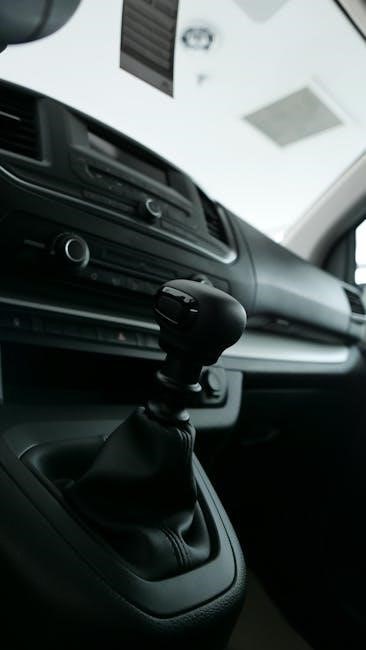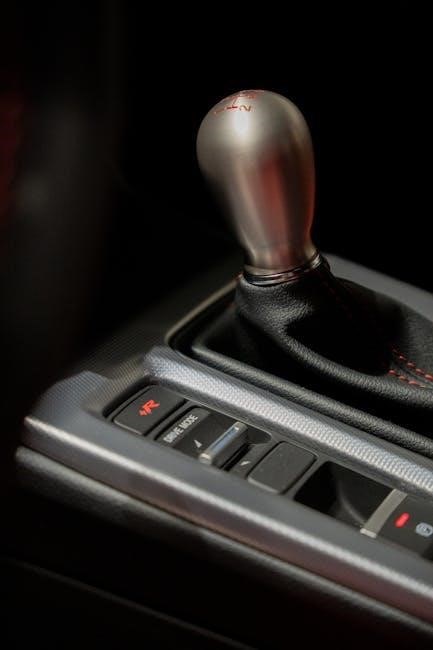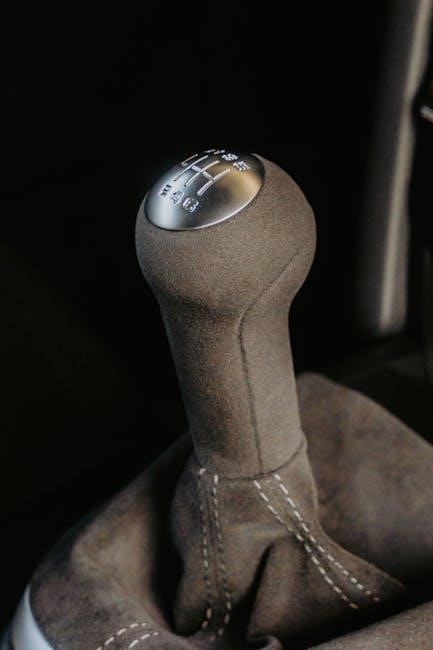Manual transmissions offer a blend of efficiency‚ control‚ and driving engagement‚ making them a popular choice for many drivers‚ despite requiring more skill and effort behind the wheel.
Overview of Manual Transmissions
Manual transmissions‚ also known as “stick shifts‚” allow drivers to manually select gears using a clutch pedal and gearshift. This system provides direct control over the vehicle‚ enhancing driving engagement and fuel efficiency. While they often require more skill and effort‚ especially in stop-and-go traffic‚ manual transmissions are prized for their simplicity‚ lower maintenance costs‚ and the connection they offer between driver and car. However‚ they can be less convenient in certain driving conditions.
Manual transmissions have a long history‚ dating back to the early 20th century. Initially complex and difficult to use‚ they evolved to become more accessible and efficient. By the mid-20th century‚ they became synonymous with performance and driver engagement‚ especially in sports cars. Despite the rise of automatics‚ manuals remain popular for their simplicity‚ fuel efficiency‚ and driving experience‚ though their market share has declined in recent years due to advancing automatic technology. Manual transmissions are designed to give drivers precise control over gear shifts‚ improving fuel efficiency and performance. By using a clutch pedal and gearstick‚ drivers manually select the optimal gear for speed and torque. This system minimizes power loss between engine and wheels‚ enhancing acceleration and efficiency. While requiring more skill‚ manuals provide a more engaging driving experience‚ appealing to enthusiasts who value connection and control behind the wheel. Manual transmissions offer numerous advantages‚ including better fuel efficiency‚ lower costs‚ and superior performance. They provide enhanced control and driving engagement‚ appealing to enthusiasts. Manual transmissions typically offer better fuel efficiency compared to automatics due to their mechanical simplicity. With direct control over gear shifts‚ drivers can optimize engine speed and torque‚ reducing fuel consumption. Studies show manuals often achieve 2-5% better mileage in city driving and up to 10% on highways. However‚ real-world efficiency depends on driving habits and terrain. Overall‚ manuals remain a top choice for eco-conscious drivers seeking lower fuel costs. Manual transmissions provide enhanced driving performance by allowing direct control over gear shifts‚ enabling drivers to optimize acceleration and responsiveness. This connectivity to the vehicle allows for smoother power delivery and better adaptability to varying road conditions. Additionally‚ manual transmissions enable engine braking‚ which improves control during descents or heavy loads. This driver-vehicle interaction enhances the overall driving experience‚ making it more engaging and precise for enthusiasts seeking superior performance and handling. Manual transmissions are generally more cost-effective than automatics‚ with lower purchase prices and reduced maintenance expenses. Fewer complex components mean less material and labor costs during production. Additionally‚ manual transmissions tend to have longer lifespans and require less frequent repairs‚ saving drivers money over time. This makes them a budget-friendly option for both new car buyers and long-term owners seeking to minimize automotive expenses. Manual transmissions provide drivers with direct control over gear shifts‚ allowing for precise acceleration and deceleration. This connectivity enhances driving dynamics‚ especially in challenging terrain or when towing. The ability to manually select gears gives drivers more command over the vehicle’s performance‚ fostering a sense of mastery and confidence behind the wheel. This level of control is often cited as a key reason enthusiasts prefer manual transmissions for a more engaging driving experience. Manual transmissions offer a more immersive driving experience‚ fostering a deeper connection between the driver and the vehicle. The act of shifting gears and clutch control creates a sense of involvement‚ making driving feel more engaging and enjoyable. For many‚ the tactile feedback and control provided by a manual transmission add a layer of excitement and satisfaction‚ turning everyday driving into a more rewarding and fun experience. Manual transmissions can be less convenient‚ requiring constant gear shifts and clutch use‚ which may cause fatigue in heavy traffic or hilly terrain. Manual transmissions require coordination between the clutch pedal and gearshift‚ which can be challenging for new drivers. Mastering smooth starts‚ avoiding stalls‚ and shifting gears seamlessly takes time and practice. The complexity of understanding when to shift gears based on speed and terrain adds to the difficulty. This learning process can be frustrating and may lead to jerky movements or stalling‚ especially in stop-and-go traffic. However‚ with practice‚ these skills become second nature. Manual transmissions can cause driver fatigue‚ especially in heavy traffic. Constantly depressing the clutch and shifting gears requires more effort and attention compared to automatics. In stop-and-go situations‚ frequent gear changes and restarting from a standstill can be tiring. This repetitive motion increases physical and mental strain‚ making long commutes more exhausting. While some drivers find it engaging‚ others may find it draining over time. Manual transmissions can be more demanding in hilly or uneven terrain. Starting on an incline often requires careful use of the clutch and throttle to avoid rolling backward. This can be stressful‚ especially for inexperienced drivers. Constant gear shifting and brake usage add to the difficulty‚ particularly on steep or winding roads. While some drivers adapt‚ others find it challenging‚ especially in frequent stop-and-go situations or when navigating sharp inclines. Manual transmissions are becoming less common in modern vehicles‚ as automakers increasingly favor automatic and CVT options. This limited availability can frustrate driving enthusiasts‚ as fewer new models offer a manual option. Even in performance-oriented cars‚ automatics often dominate. The decline reflects shifting consumer preferences toward convenience and ease of use‚ making manual transmissions a niche choice in today’s automotive market. This trend may continue as technology advances. Manual transmissions can be less practical in heavy traffic or stop-and-go driving‚ as constant shifting and clutch engagement can be tiring. In hilly or uneven terrain‚ drivers must frequently adjust gears‚ which can be challenging. Additionally‚ in extreme weather conditions like snow or ice‚ manual transmissions may require more skill to maintain traction‚ potentially leading to reduced performance and increased driver fatigue in such situations; Manual transmissions offer better fuel efficiency and driver control but require more skill and effort. Automatics provide ease and convenience‚ especially in traffic‚ but often lack the engagement and performance of manuals. Each suits different driving styles and preferences‚ making the choice depend on individual needs and priorities. Manual transmissions offer distinct advantages‚ including better fuel efficiency‚ lower purchase costs‚ and enhanced driver control. They provide a more engaging driving experience and are often lighter‚ improving performance. Manuals typically require less maintenance and are more reliable in the long term. These benefits make manual transmissions appealing for drivers seeking a more connected and cost-effective driving experience‚ especially for those who enjoy driving enthusiasts. Manual transmissions have a steeper learning curve‚ requiring drivers to master clutch and gear coordination. They can cause driver fatigue in heavy traffic due to constant shifting. Manuals are less convenient in hilly or stop-and-go conditions‚ and their availability is declining in modern vehicles. Additionally‚ they may not be as smooth or comfortable for inexperienced drivers‚ making automatics preferable for many everyday commuters seeking ease and convenience. Manual transmissions offer better control and driving engagement compared to CVTs‚ which prioritize smooth‚ efficient operation. CVTs excel in fuel efficiency but lack the tactile experience of manuals. Manual transmissions often provide better fuel efficiency in city driving due to precise gear control‚ while CVTs optimize efficiency on highways with infinite ratios. Manuals deliver quicker acceleration and a more direct driving feel‚ whereas CVTs can feel less responsive due to their continuous adjustment. However‚ CVTs may offer smoother operation in stop-and-go traffic‚ though they often lack the engagement and performance edge of manuals for enthusiast drivers. Manual transmissions offer a more engaging and tactile driving experience‚ with precise control over gear shifts‚ making them popular among enthusiasts. CVTs‚ however‚ provide a smoother and more convenient ride‚ especially in stop-and-go traffic‚ but often lack the direct feedback of manuals. Manuals are generally more reliable and require less complex components‚ while CVTs‚ though improving‚ can be less durable and more expensive to repair‚ affecting long-term reliability. Manual transmissions provide a tactile feel and precise control‚ fostering a deeper connection between driver and vehicle. Engaging gears manually enhances the joy of driving. Manual transmissions offer unparalleled driver engagement‚ requiring active participation through gear shifts and clutch control‚ which heightens the connection between the driver and the vehicle. This hands-on interaction creates a more immersive and satisfying driving experience‚ especially for enthusiasts who value precision and control. Mastering the skill of shifting gears adds to the sense of accomplishment‚ making every drive feel more engaging and rewarding compared to automatic transmissions. Manual transmissions are less suitable for stop-and-go traffic due to the constant need for gear shifting and clutch engagement‚ leading to driver fatigue. Frequent stopping and starting require continuous clutch and accelerator operation‚ making the experience more tiresome. This repetitive action can be frustrating‚ especially for inexperienced drivers who are still mastering smooth transitions and avoiding stalls in traffic‚ thus increasing the learning curve significantly. Manual transmissions usually need less maintenance‚ with lower repair costs due to fewer components. They often cost less to purchase‚ providing budget-friendly options for many drivers. Manual transmissions generally require less frequent maintenance compared to automatics. They have fewer complex components‚ reducing the need for costly repairs. However‚ clutch replacement is a common maintenance task‚ typically needed every 50‚000 to 100‚000 miles‚ depending on driving habits. Regular fluid changes and inspections are also essential to ensure smooth operation. Overall‚ manual transmissions are simpler in design‚ leading to lower long-term maintenance costs and greater reliability for drivers. Manual transmissions are often more cost-effective than automatics‚ with lower purchase prices and reduced long-term expenses. They typically require less expensive repairs and replacements due to fewer complex components. Fuel savings also contribute to overall affordability‚ as manuals generally achieve better mileage. Additionally‚ used vehicles with manual transmissions often cost less‚ making them a budget-friendly option for drivers seeking reliability and value without compromising on performance. Manual transmissions involve an initial learning curve‚ requiring proper coordination of clutch and accelerator. Mastery enhances driving skills and offers a greater sense of accomplishment for drivers. Novice drivers face challenges mastering clutch control‚ smooth shifting‚ and coordinating acceleration. Stalling frequently occurs during the learning process‚ causing frustration. In heavy traffic or uphill starts‚ maintaining control can be daunting. The physical and mental demands of manual driving require practice to build muscle memory and confidence. Consistent effort is essential to overcome these hurdles and achieve proficiency in operating a manual transmission effectively. Regular practice is crucial for mastering manual transmissions‚ as it builds muscle memory and coordination between clutch and accelerator. Consistent effort helps drivers transition smoothly between gears‚ reducing stalling and gear grinding. Over time‚ this practice enhances control‚ allowing for better fuel efficiency and smoother driving. Mastery of these skills not only improves driving confidence but also prolongs the lifespan of the transmission. Practice is the foundation of becoming a proficient manual driver. Manual transmissions offer enhanced security‚ as they deter theft due to fewer drivers being familiar with them. They also provide better control in emergencies‚ improving safety. Manual transmissions can pose safety risks‚ especially for inexperienced drivers. Stalling in emergencies or heavy traffic increases accident potential. Additionally‚ the need to focus on gear shifting may distract drivers‚ reducing reaction times. In hilly terrain‚ improper clutch and accelerator coordination can lead to loss of control. These challenges highlight the importance of skill mastery for safe operation. Manual transmissions offer unique security advantages. They are less likely to be targeted by thieves‚ as not everyone knows how to drive them. In carjacking situations‚ a manual transmission can provide an edge‚ as attackers unfamiliar with manual shifting may struggle to control the vehicle. This can potentially allow drivers to regain control or escape safely‚ enhancing overall security in critical situations. Manual transmissions often retain higher resale value‚ especially in sports or performance vehicles‚ due to demand from driving enthusiasts. This niche market preference can boost resale prices. Manual transmission vehicles often hold higher resale value‚ particularly in performance or sports cars‚ due to strong demand from driving enthusiasts. This niche appeal can result in better resale prices compared to automatic counterparts‚ especially in markets where manual transmissions are less common. However‚ regional preferences play a role‚ as demand varies by location and cultural driving habits. Market demand for manual transmissions has declined in recent years‚ as automatic and CVT options gain popularity. However‚ manuals remain sought after by driving enthusiasts and in regions with strong car cultures. Many manufacturers continue to offer manual options in performance or niche vehicles‚ catering to a dedicated audience. This demand ensures manuals remain relevant‚ even as their overall market share diminishes. Manual transmissions often provide better fuel efficiency‚ leading to lower emissions. Their simpler design also generally requires fewer resources for production‚ reducing environmental impact. Manual transmissions typically offer better fuel efficiency compared to automatics due to their simpler design and direct power delivery. This increased efficiency reduces greenhouse gas emissions‚ making them a more environmentally friendly option. Additionally‚ the driver’s control over gear shifts encourages more economical driving habits‚ further lowering emissions. Over time‚ this can contribute to a smaller carbon footprint‚ especially in urban and stop-and-go driving conditions where fuel savings are more pronounced. Manual transmissions are known for their durability and longer lifespan compared to automatics. With fewer complex components‚ they require less frequent repairs and replacements when properly maintained. This sustainability reduces electronic waste and resource consumption. Additionally‚ manual transmissions are often lighter‚ which lowers production-related environmental impacts. Their repairability and longevity make them a more sustainable choice‚ aligning with eco-friendly and cost-effective driving practices over the long term. Manual transmissions offer a balance of fuel efficiency‚ control‚ and cost-effectiveness but require skill and effort. While they suit driving enthusiasts‚ their demand is declining due to automatics’ convenience. Manual transmissions offer better fuel efficiency‚ lower costs‚ and superior performance‚ making them ideal for driving enthusiasts. They provide greater control and a more engaging experience. However‚ they require a steeper learning curve‚ can cause fatigue in traffic‚ and may struggle in hilly terrain. Limited availability in modern vehicles and challenges in certain driving conditions are additional drawbacks. Ultimately‚ manual transmissions suit skilled drivers seeking a connected driving experience but may not be practical for all. Manual transmissions remain a beloved choice for driving purists‚ offering unmatched control‚ efficiency‚ and engagement. While they may not suit every lifestyle due to their learning curve and challenges in certain conditions‚ they provide significant benefits for those willing to master them. Their unique blend of performance‚ cost savings‚ and driving satisfaction makes them a rewarding option for enthusiasts‚ even as automatics dominate modern vehicles. A Brief History of Manual Transmissions
Purpose and Function of Manual Transmissions

Pros of Manual Transmissions
Better Fuel Efficiency
Enhanced Driving Performance
Lower Purchase and Maintenance Costs
Greater Control Over the Vehicle
Driving Engagement and Fun Factor

Cons of Manual Transmissions
Steeper Learning Curve
Increased Driver Fatigue in Traffic
This can reduce overall driving comfort.Challenges in Hilly or Uneven Terrain
This can make driving less enjoyable.Limited Availability in Modern Vehicles
Potential Drawbacks in Certain Driving Conditions

Comparison with Automatic Transmissions
Advantages of Manual vs. Automatic
Disadvantages of Manual vs. Automatic

Comparison with CVT (Continuously Variable Transmission)
Manual vs. CVT: Fuel Efficiency and Performance
Manual vs. CVT: Driver Experience and Reliability

Driving Experience with Manual Transmissions
Driver Engagement and Satisfaction
Suitability for Stop-and-Go Traffic

Maintenance and Cost Considerations
Maintenance Requirements for Manual Transmissions
Cost Benefits of Manual Transmissions

Learning Curve and Skill Development
Challenges for Novice Drivers
Importance of Practice and Skill Mastery

Safety and Security Aspects
Safety Concerns with Manual Transmissions
Security Benefits of Manual Transmissions
Resale Value and Market Demand
Resale Value of Manual Transmission Vehicles
Market Demand for Manual Transmissions

Environmental Impact
Fuel Efficiency and Emissions
Longevity and Sustainability of Manual Transmissions
Final Thoughts on Manual Transmissions
